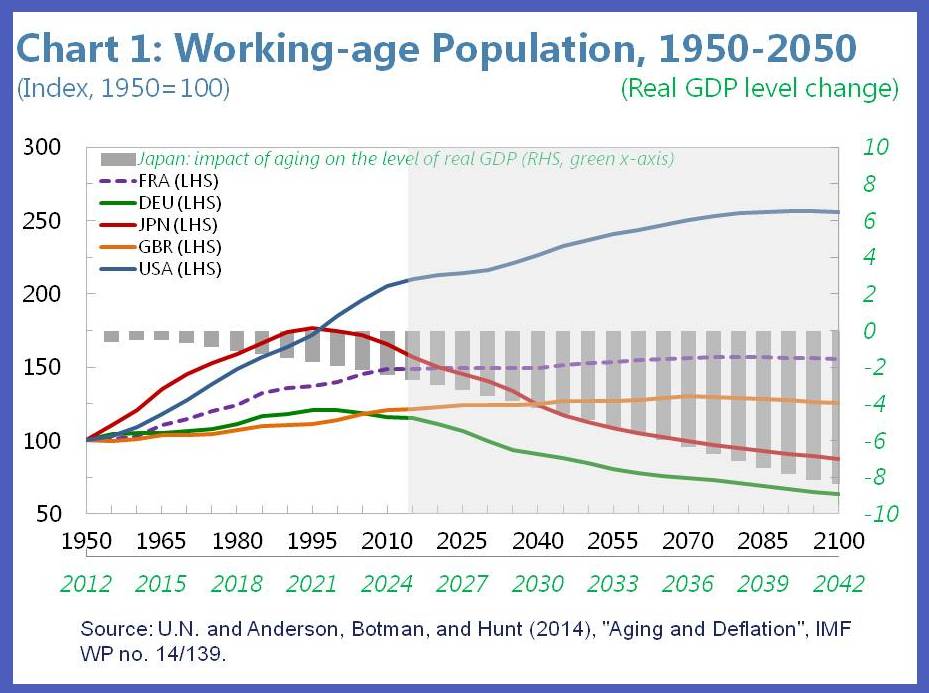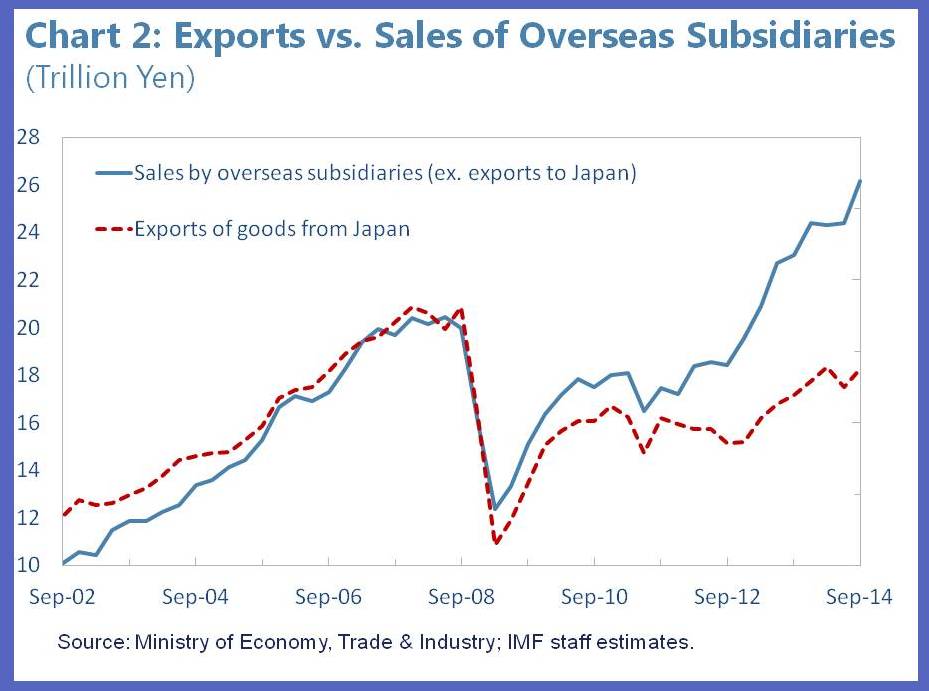(Versions in 日本語)
Abenomics can succeed, despite recent setbacks to growth and inflation, in revitalizing Japan by making steadfast progress on all three of its arrows equally and simultaneously, as we show in our new book. This is also essential to avoid an undue weakening of the yen and ensure positive spillovers to Japan’s neighbors, its region, and the global economy.
The Legacy: Structural Changes During the Lost Decades
Most Japan followers will be familiar with the following striking statistic: in 2013, Japan’s level of nominal GDP was about 6 percent below its mid 1990s level. During this period, three important structural changes have been a brake on growth and efforts to get out of deflation:
- Population aging, which started in earnest around the mid-1990s, has been a drag on growth by reducing labor input, land prices, and aggregate demand, contributing to deflationary pressures (see chart 1). It has contributed to the erosion of the traditional tax base and increased government outlays on health care and social security, adding to Japan’s fiscal woes. It also raised demand for “safe assets,” limiting the financial sector’s ability to be a catalyst for growth by providing risk capital.
- Production offshoring, which initially contributed to the corporate deleveraging process, has recently occurred at the expense of domestic investment and exports from Japan (see chart 2), while higher corporate profits are increasingly retained as cash holdings.
- Labor market fragmentation. Japan used to be famous for its lifetime employment model, especially for men in large companies, but a dramatic change has occurred in recent years with the emergence of nonregular workers, especially women and older workers. Excessive labor market duality has recently become an impediment for efforts to get out of deflation by limiting aggregate nominal wage and productivity growth (see chart 3).
 Past policy efforts to overcome these headwinds proved to be largely unsuccessful, due to their on-off and generally uncoordinated implementation and because of large shocks that beset the country just when the situation started to improve such as the Asian financial crisis, the bursting of the dot-com bubble, the global financial crisis, and the 2011 earthquake and tsunami.
Past policy efforts to overcome these headwinds proved to be largely unsuccessful, due to their on-off and generally uncoordinated implementation and because of large shocks that beset the country just when the situation started to improve such as the Asian financial crisis, the bursting of the dot-com bubble, the global financial crisis, and the 2011 earthquake and tsunami.
Mutual synergies from implementing all three arrows
In early 2013, Japan embarked on a comprehensive and coordinated set of policies to end deflation, raise growth, secure fiscal sustainability, while maintaining financial stability. The so-called three arrows of Abenomics comprise aggressive monetary easing, flexible fiscal policy, and ambitious structural reforms.
With the first arrow, ending deflation would reduce the government debt ratio and restore the effectiveness of conventional monetary policy. Further, it could rekindle animal spirits and stimulate productivity growth. As such, the aggressive monetary easing by the Bank of Japan remains appropriate and instrumental in pushing up actual and expected inflation. Nonetheless, policy transmission appears relatively constrained: investment remains sluggish despite negative real interest rates, exports remain tepid despite the depreciation of the yen, and portfolio rebalancing towards higher-yielding assets remains limited.
The rise in inflation expectations and tight labor market conditions are only slowly feeding through into higher basic wages. These modest effects are, in part, due to the structural headwinds mentioned earlier from aging, production outsourcing, and labor market duality suggesting that structural reforms are essential to help attain the 2 percent inflation target.
The second arrow depends, in no small part, on the credibility of the government’s fiscal adjustment strategy. This creates a difficult balancing act: one the one hand, fiscal policy needs to support the economic recovery, but at the same time it cannot lose sight of the large and ever increasing debt overhang. A concrete medium-term fiscal consolidation that aims to put debt on a downward trajectory through revenue measures and entitlement reforms remains the preferred solution to this dilemma: such a plan would provide assurances that the debt will be repaid, allowing greater scope in the near term for stimulus when downside risks materialize or structural fiscal measures are taken.
The third arrow of ambitious structural reforms are pivotal for both the near-term and longer-lasting success of Abenomics. Groundbreaking structural reforms will already support demand in the near term as confidence and expectations of permanent income would rise. Furthermore, as we have seen recently in Europe, fiscal consolidation without faster growth is unlikely to succeed. In this regard, bold measures that raise the employment of women, older workers, and foreign labor are most needed as they would directly counteract the effects of population aging.
Finally, the financial sector is not an innocent bystander in this debate and reforms should focus on jumpstarting the securitization market and stimulating venture capital to spur faster growth in funding for new business, and restructuring and exit of nonviable small and medium-sized enterprises (SMEs). On the latter, entry and exit rates of SMEs in Japan are on average about one-third of those in advanced countries, which impedes credit intermediation and risk taking by deterring entry of new firms, expansion of healthy firms, and by eroding risk assessment capabilities at banks.
The IMF’s new book “Can Abenomics Succeed? Overcoming the Legacy of the Lost Decades” by authors Dennis Botman, Stephan Danninger,and Jerald Schiff brings together two years of research on the effects of Abenomics and the reform agenda ahead.






